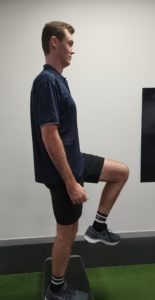Why do regular walking?
Walking is one activity that can be done everyday and does not require anything other than your shoes, motivation and a little bit of time. This can be activity that you enjoy by listening to some music, walking home from work, going for a walk with your family and taking your dog for a walk. While walking might not feel like much, a regular amount of it each week has amazing benefits including improving sleep, mood, general wellbeing, muscle strength, joints, and decreasing risks of heart disease.
See below our top tips on ways of improving stability and balance for walking, which will reduce the risks of injuries and falls as well as assisting you to achieve your walking and fitness goals.
Balance and walking mobility training exercise can include:
The exercises listed below will not only help strengthen the legs, hip and core muscles but also train your body to respond better to balance, which will improve your walking stability.
Step ups
Find a stair of manageable height. Place your whole foot on the stair and push through your heel as you step up. Then slowly lower. You can step up and raise the opposite knee to include some balance. Repeat this 10 times and then alternate to your left foot.


Pillow balance
To improve stability through your feet and ankles try doing some balancing exercises on unstable surfaces. You can start with carpet or grass then progress to a pillow. Try in a double hip width stance then progress to heel toe and then finally to single leg balances.

Heal-toe walking
Put your right foot in front of your left foot ensuring that the heel of your right foot touches the top of the toes on the left foot.

Walking on an incline
This can be achieved by using a treadmill and raising the incline or walking up a hill or footpath with an incline. To increase balance progression try walking on the treadmill without holding and vice versa if you need more assistance.
Side leg raises
Start by lying on the left side of your body. Keeping your hip straight gently lift your right leg up to 45 degrees and then slowly return. Try and isolate the movement to the hip and keep from your hips up still. Repeat this ten times and then switch to the right side of your body and repeat this with your left leg.
Calf raisers
Standing on both feet, lift up onto your toes and then slowly bring your heels back to the ground and repeat. Ensure that you don’t fall out or roll in throughout the movement.

Sit to stands
Sit in the middle of the chair but towards the front. Place your feet flat on the ground, hip width apart. When ready, push through your heels and stand to a complete upright position and then slowly sit on the chair or tap your bottom and repeat.


Glute bridges
Lay on your back and have your knees bent with your feet flat on the ground. Lay your arms flat on the ground either side of you, keeping your hips straight and find the natural curve in your spine. Push through your heels and lift into a bridge position, hold for a few seconds and bring yourself back down to the ground and repeat.


Group exercises for improving balance
If you are wanting to improve your walking stability and balance in a group setting, classes with a focus on pilates, yoga, or tai chi would be the most beneficial. These classes have a focus on flexibility, balance, and strengthen muscles as well as reducing stress and improving general wellbeing.
Pilates
Pilates is focused on improving flexibility, strengthening of core and lower back muscles. Additionally, Pilates improves your wellbeing and the relaxation of the shoulders, neck and back.
Tai Chi
The goal of Tai Chi is that you move slowly through a range of exercises in a relaxed and calming environment, focusing on your breathing, and reducing stress, removing any tension throughout the body. The benefits of Tai Chi include the improving of your general wellbeing, flexibility, balance, breathing, and muscle strength.
Yoga
Some of the many benefits of yoga include improving your range of motion, cardiovascular fitness, joint tension, stiffness, and flexibility and shown to reduces stress and improve general wellbeing.
Walking is something that is simple, enjoyable, and super effective for chronic disease management and prevention. By incorporating into social meet ups, commuting and some time on your own you can easily squeeze some into your day. The guidelines for cardiovascular exercise are 3-5hrs per week so try starting with 20-30mins each day and gradually increasing. Ensuring to accompany your walking program with stretching and strength for longevity. Disease prevention and management is all about daily habits and healthy lifestyle. Need some extra motivation? Our team is currently doing the March Charge you can join us and charge for cancer by donating or joining our team here.
References
https://www.betterhealth.vic.gov.au/health/conditionsandtreatments/pilates-and-yoga-health-benefits
https://www.diabetesqld.org.au/news/boost-your-strength-and-balance/
https://exerciseright.com.au/balance-training-for-falls-prevention/
https://exerciseright.com.au/top-3-benefits-walking-exercise

